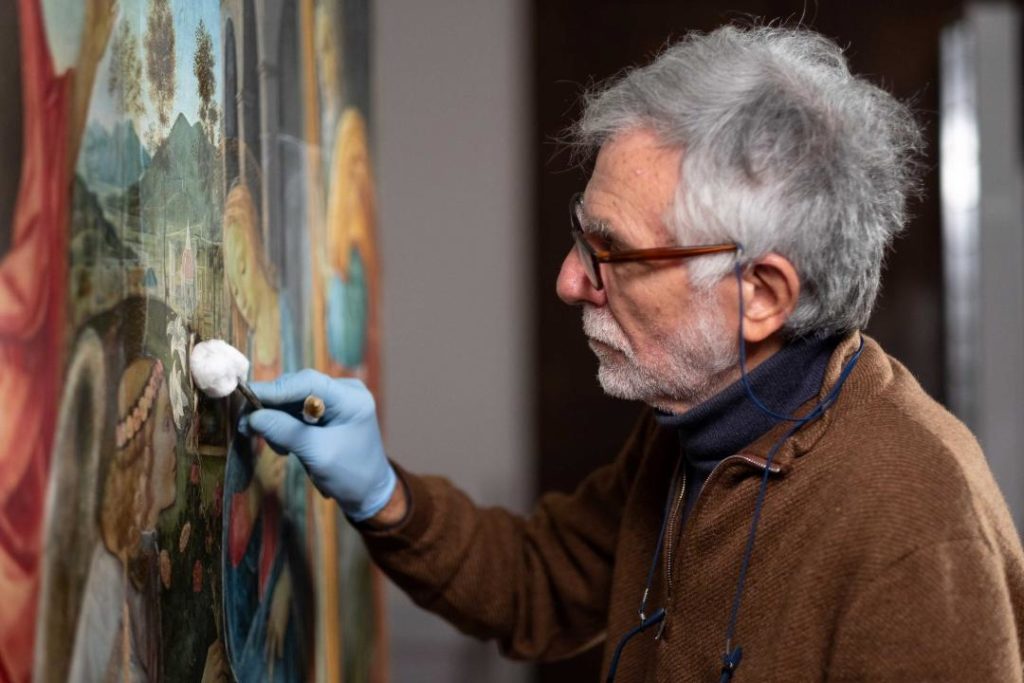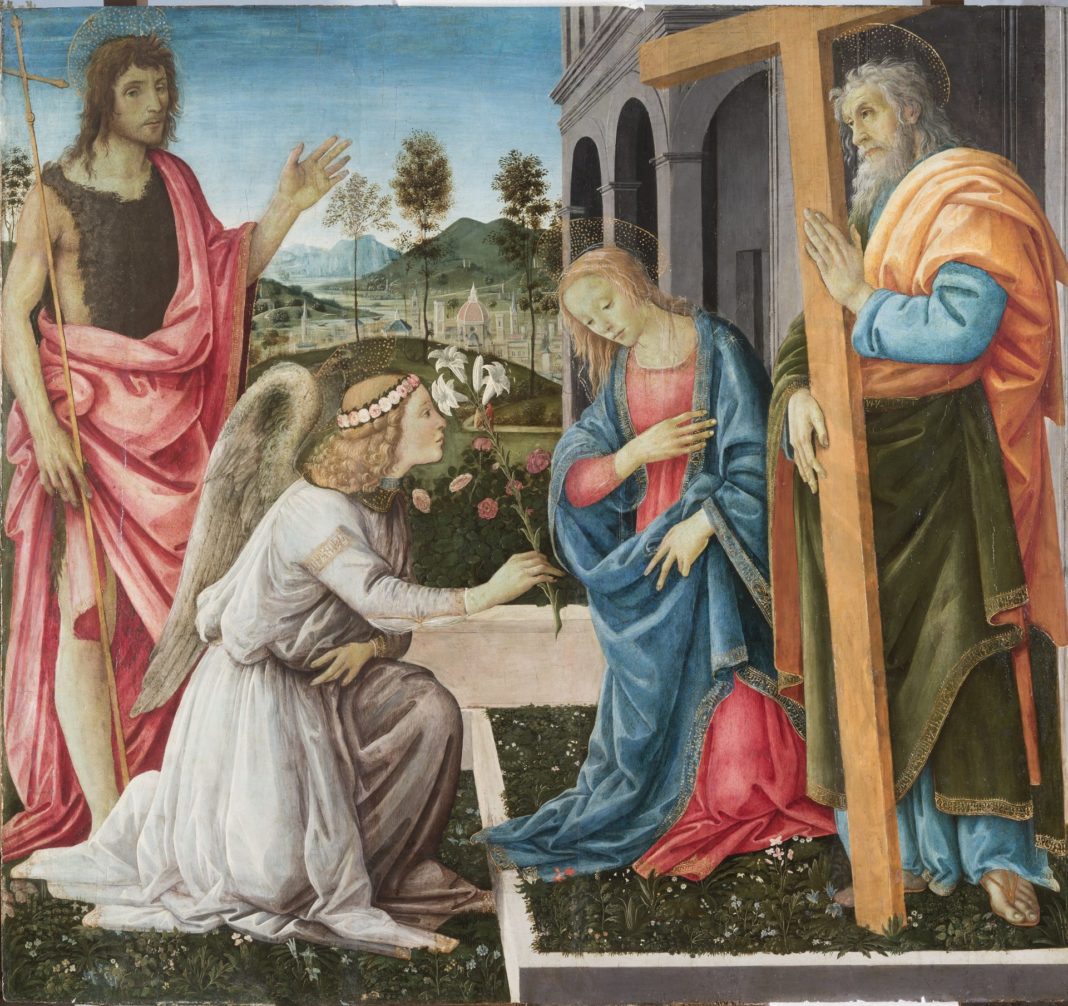- Torna nelle sale di Capodimonte un dipinto di Filippino Lippi. Si tratta dell’Annunciazione e i santi Giovanni Battista e Andrea, opera restaurata grazie all’azienda Temi Spa che ha utilizzato le agevolazioni fiscali dell’Art Bonus.
La stessa azienda aveva già sostenuto il Museo il restauro di un’altra tela, il ritratto dell’infante Francesco I di Borbone di Elisabeth Vigée Le Brun, per il progetto “Rivelazioni Finance for Fine Art” in corso dal 2018 tra Borsa Italiana e advisory board di Capodimonte.
In questo stesso ambito, s’inserisce il recupero del Filippino Lippi completando un’operazione di successo che coinvolto ben otto importanti dipinti del Museo, come l’Adorazione dei Pastori di Giovan Battista Salvi detto il Sassoferrato, la Natività di Luca Signorelli, La Cantatrice di Bernardo Cavallino e Adorazione del Bambino di Michelangelo Anselmi, il Paesaggio con la Ninfa Egeria di Claude Lorrain, il Ritratto dell’infante Francesco di Borbone di Elisabeth Vigée Le Brun e il Ritratto di Pier Luigi Farnese di Tiziano.
I restauri sono stati compiuti resi grazie ad aziende campane aderenti al progetto ELITE, il programma internazionale di Borsa Italiana nato nel 2012 in collaborazione con Confindustria dedicato alle imprese con un alto potenziale di crescita: la D&D Italia Spa di Sabato D’Amico, la Protom di Fabio De Felice, la Cartesar di Fulvio De Iuliis, la Epm di Carmine Esposito, la Pasell di Salvatore Amitrano, la Graded di Vito Grassi, la Tecno srl di Giovanni Lombardi e la Caronte Spa
di Gennaro Matacena.
L’Annunciazione di Filippino Lippi è stata restaurata da Bruno Arciprete, sotto la direzione lavori di Angela Cerasuolo, responsabile del Dipartimento restauro del Museo e Real Bosco di Capodimonte
con indagini condotte da Beatrice De Ruggieri, Matteo Positano, Marco Cardinali (Emmebi Diagnostica Artistica) e Claudio Falcucci.
Il restauro verrà presentato domani, giovedì 27 luglio (ore 12), al primo piano del Museo di Capodimonte, da Cerasuolo e Arciprete insieme al direttore Sylvain Bellenger e al presidente di Themi spa, Francesco Tavassi.
Ma chi è Filippino Lippi? L’artista nasce a Prato dall’unione illegittima tra il celebre pittore e frate carmelitano Filippo e la monaca agostiniana Lucrezia Buti, figlia di un mercante fiorentino. Avviato prestissimo alla pittura, è già registrato fra i ‘garzoni’ della bottega paterna nel cantiere del Duomo di Spoleto, dove Filippo si reca nel 1467 e trova la morte due anni dopo.
Filippino continua quindi a condurre la sua attività inizialmente a fianco di Fra Diamante, principale collaboratore del padre. Da questi si discosta però entro il 1472, anno in cui è registrato nella bottega di Sandro Botticelli, già con una certa autonomia e non esattamente come suo allievo. Gli studi più recenti stanno ricostruendo l’attività dei primissimi anni di Filippino presupponendo questo precocissimo apprendistato presso il padre, e quindi “l’avvio del percorso artistico del Lippi, parallelo e non in esclusiva dipendenza da quello di Botticelli”.
L’Annunciazione di Capodimonte è un importante testimonianza di questa fase iniziale del giovane maestro. Si può ipotizzare infatti una datazione veramente molto precoce per il dipinto, alla luce di quanto il restauro ha consentito di comprendere sulla sua esecuzione, caratterizzata da modifiche, aggiustamenti, esitazioni nel passaggio dal disegno iniziale alla stesura pittorica, che si è rivelata in tutto il suo nitore, preziosa e delicata ma non sempre salda.
Il restauro ha restituito al dipinto tutto il nitore dei colori tersi e armoniosi, rendendo meglio leggibile il ductus elegante a punta di pennello con cui sono costruiti i panneggi, i lineamenti delicati dei protagonisti e il cielo luminoso che splende dietro la veduta della città di Firenze.

Capodimonte/ Filippino Lippi’s Annunciation is back in museum galleries after restoration. In the harmony of its colors
- A painting by Filippino Lippi is back in the halls of Capodimonte. It is the Annunciation and Saints John the Baptist and Andrew, a work restored thanks to the company Temi Spa, which used Art Bonus tax benefits.
- The same company had already supported the museum’s restoration of another canvas, the portrait of the Infante Francesco I di Borbone by Elisabeth Vigée Le Brun, as part of the “RivelazioniFinance for Fine Art” project carried out in 2018 by Borsa Italiana in collaboration with the Advisory Board of the Museo e Real Bosco di Capodimonte.
- In this same sphere, fits the recovery of Filippino Lippi completing a successful operation that involved as many as eight important paintings in the Museum, such as the Adoration of the Shepherds by Giovan Battista Salvi known as Sassoferrato, the Nativity by Luca Signorelli, Bernardo Cavallino’s La Cantatrice and Michelangelo Anselmi’s Adoration of the Child, Claude Lorrain’s Landscape with the Nymph Egeria, Elisabeth Vigée Le Brun’s Portrait of the Infant Francis of Bourbon, and Titian’s Portrait of Pier Luigi Farnese.
- The restorations were made thanks to companies from Campania that are members of the ELITE project, the international program of Borsa Italiana established in 2012 in collaboration with Confindustria dedicated to companies with high growth potential: Sabato D’Amico’s D&D Italia Spa, Fabio De Felice’s Protom, Fulvio De Iuliis’ Cartesar, Carmine Esposito’s Epm, Salvatore Amitrano’s Pasell, Vito Grassi’s Graded, Giovanni Lombardi’s Tecno srl, and Caronte Spa of Gennaro Matacena.Filippino Lippi’s Annunciation was restored by Bruno Arciprete, under the working direction of Angela Cerasuolo, head of the Restoration Department of the Capodimonte Museum and Real Bosco with investigations conducted by Beatrice De Ruggieri, Matteo Positano, Marco Cardinali (Emmebi Diagnostica Artistica) and Claudio Falcucci.
- Filippino Lippi’s Annunciation was restored by Bruno Arciprete, under the working direction of Angela Cerasuolo, head of the Restoration Department of the Capodimonte Museum and Real Bosc with studies conducted by Beatrice De Ruggieri, Matteo Positano, Marco Cardinali (Emmebi Diagnostica Artistica), Marco Cardinali (Emmebi Diagnostica Artistica Artistica), and Claudio Falcucci (Emmebi Diagnostica Artistica Artistica).
- The restoration will be presented tomorrow, Thursday, July 27 (12 noon), on the second floor of the Capodimonte Museum, by Cerasuolo and Arciprete together with director Sylvain Bellenger and the president of Themi spa, Francesco Tavassi.
- But who was Filippino Lippi? The artist was born in Prato from the illegitimate union between the famous painter and Carmelite friar Filippo and the Augustinian nun Lucrezia Buti, daughter of a Florentine merchant. Initiated into painting at a very early age, he is already registered among the ‘garzoni’ in his father’s workshop on the building site of Spoleto Cathedral, where Filippo went in 1467 and found death two years later.
- Filippino then continued to conduct his activity initially at the side of Fra Diamante, his father’s main collaborator. However, he departs from these by 1472, the year in which he is recorded in Sandro Botticelli’s workshop, already with a certain autonomy and not exactly as his pupil. More recent studies are reconstructing the activity of Filippino’s earliest years by assuming this precocious apprenticeship at his father’s, and thus “the start of Lippi’s artistic path, parallel to and not in exclusive dependence on that of Botticelli.”
- The Capodimonte Annunciation is an important testimony to this early stage of the young master. In fact, a truly very early date for the painting can be hypothesized in light of what the restoration has allowed us to understand about its execution, which was characterized by changes, adjustments, and hesitations in the transition from the initial drawing to the pictorial drafting, which was revealed in all its clarity, precious and delicate but not always firm.
- The restoration has returned to the painting all the clarity of the terse and harmonious colors, making better legible the elegant brush-point ductus with which the draperies are constructed, the delicate features of the protagonists and the bright sky shining behind the view of the city of Florence.










